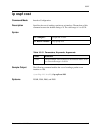
Chapter 19
19-10 Command Reference Guide for the Avaya P580 and P882 Multiservice Switches, v6.1
area virtual-link
Command Mode OSPF Router Configuration.
Description Defines an OSPF virtual link. To remove a virtual link, use the no form of
this command.
Syntax
To Configure: area <area-id> virtual-link <router-id> [hello-interval
<hello-interval>] [retransmit-interval <retransmit-
interval>] [dead-interval <dead-interval>] [transit-
delay <transit-delay>] [{authentication-key <passwd>
| message-digest-key <key-id> md5 <key>}]
To Disable: [no] area <area-id> virtual-link <router-id>
Table 19-8. Parameters, Keywords, Arguments
Name Definition
<area-id> IP address that represents the area-id for the system.
<router-id> Router ID associated with the virtual link neighbor. The
router ID appears in the show ip ospf display. It is internally
derived by each router from the router’s interface IP
addresses. This value must be entered in the format of an IP
address. There is no default.
<hello-interval> Time in seconds between the hello packets that the Cisco IOS
software sends on an interface. Unsigned integer value to be
advertised in the software’s hello packets. The value must be
the same for all routers and access servers attached to a
common network. The default is 10 seconds.
<retransmit-
interval>
Time in seconds between link state advertisement
retransmissions for adjacencies belonging to the interface.
Expected round-trip delay between any two routers on the
attached network. The value must be greater than the
expected round-trip delay. The default is 5 seconds.
<dead-interval> Time in seconds that a software’s hello packets are not seen
before its neighbors declare the router down. Unsigned
integer value. The default is four times the hello interval, or
40 seconds. As with the hello interval, this value must be the
same for all routers and access servers attached to a common
network.
1 of 2


















